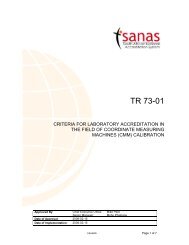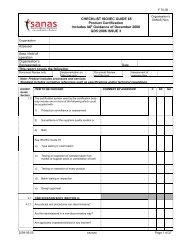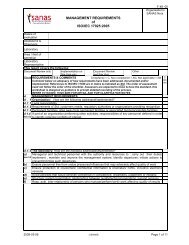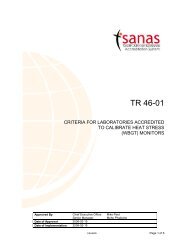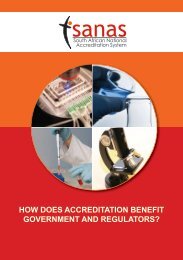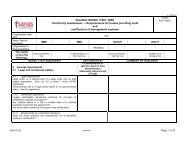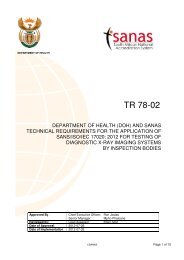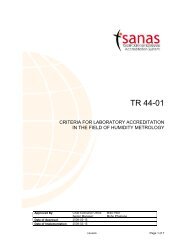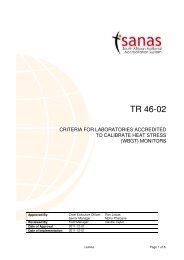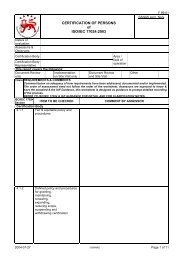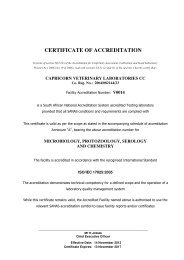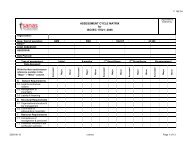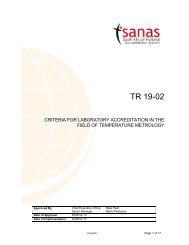TR 07-02 - Sanas
TR 07-02 - Sanas
TR 07-02 - Sanas
- No tags were found...
Create successful ePaper yourself
Turn your PDF publications into a flip-book with our unique Google optimized e-Paper software.
<strong>TR</strong> <strong>07</strong>-<strong>02</strong>CONTENTS:1. Purpose and Scope2. Definitions and References3. Introduction4. Requirements4.1 Monitoring Objectives4.2 Monitoring Plan4.3 Monitoring Station Design and Site (Probe) Location and Sampling System4.4 Meteorological Requirements4.5 Calibration Requirements4.6 Data Management Protocols4.7 Accredited Data4.8 Data Acquisition (Logging Devices)4.9 Data Validation4.10 Reporting of Data & Compliance to Specification4.11 Staff Competence4.12 Internal Audits4.13 Proficiency Testing5. BibliographyAPPENDIX A: Criteria for Representativeness of DataADDENDUM 1: Amendment Record©SANAS Page 2 of 12
<strong>TR</strong> <strong>07</strong>-<strong>02</strong>4.3 Monitoring Station Design and Site (Probe) Location and sampling system4.3.1 For compliance monitoring refer to the National Framework for Air QualityManagement in the Republic of South Africa, 20<strong>07</strong> and Limits for common pollutants,SANS 1929:2009. The facility shall validate any deviations from these requirementsand consider any significant impacts and seek agreement with the customer.4.3.2 The minimum requirements for station design, location, & sampling system are:a) Ambient analysis equipment must be designated as equivalent methods by theEPA or other internationally recognised bodies for example USEPA, TUV orMCERT.b) Test procedures employed must be equivalent to those employed byorganisations such as EPA and TUV using accredited laboratories.c) The enclosure must be weatherproofed and temperature controlled.d) The station must be secure and allow only restricted access.e) The station must be clear of tall obstructions that may impede measurements.f) The sample train should be designed with a minimum of kinks, joints, reducers,etc.g) The sample manifold should be designed for easy cleaning and cleaning shouldbe carried out at least monthlyh) The sample manifold and system must be routinely checked for leaks.i) The entrance to the probe should be located 3-15m above ground level.j) If located on the side of a building, it should be on the windward side relevant tothe prevailing winter wind direction.k) The probe inlet should be at least 1m vertically or horizontally away from anysupporting structure and also away from dirty, dusty areas.l) No furnaces or incineration flues or other minor sources of pollution (SO 2 )should be nearby.m) If the inlet probe is located on top of a roof or other structure, it must be at least1m from walls, parapets, etc.n) The inlet to the probe must be located away from tall buildings or obstacles.The distance between the inlet probe and the obstacle must be at least twicethe height that the obstacle protrudes above the inlet of the probe.o) Air flow must be unrestricted in an arc of at least 270° around the probe inletand the predominant wind direction for the season of greatest pollutantconcentration potential included in the 270° arc.p) If the probe is located on the side of a building, 180° clearance is required.q) Inlet sample material must be manufactured from borosilicate glass or FEPTeflon or their equivalents.r) Sample residence time must be less than 20 seconds.s) Trees can provide surfaces for absorption and act as an obstruction to normalwind flow patterns.©SANAS Page 5 of 12
<strong>TR</strong> <strong>07</strong>-<strong>02</strong>t) To minimize the possible effects of trees on the measured SO 2 levels, thesampler inlet should be placed at least 20m from the drip line of trees. Insituations where trees could be classified as an obstruction, i.e. the distancebetween the tree(s) and the probe inlet is less than twice the height that thetree(s) protrudes above the sample inlet, the inlet must be placed at least 10mfrom the drip line of the obstructing tree(s).u) Temperature and Humidity• A monitoring station requires a suitable environment with specificenvironmental conditions.• Cognisance must be taken of the ambient external conditions with regardto dew point.• Shelter temperature must be controlled at 25 °C ± 5 °C.• Should the temperature rise to above 30 °C, the data must be flagged forpossible erroneous results.v) Sampling Lines• In order to ensure adequate sampling response time the sampling linesshall be Teflon.• They must be in one piece with no additional traps and filter mechanismsallowed and should preferably be no longer than 2 meters in length fromthe manifold to the analyser.• They must be at least 6mm outer diameter in width.w) Sampling Manifold• The sampling manifold must be made from borosilicate glass or FEPTeflon or their equivalent.• The sample residence time within the manifold must be less than 20seconds.4.4 Meteorological Requirements4.4.1 Meteorological conditions are important in assessing the impacts of sources onsurrounding areas because they dictate the transport and dispersion of contaminantsin ambient air.4.4.2 The minimum meteorological parameters to be measured and reported at the samefrequency as the primary pollutants are: wind speed, wind direction and ambienttemperature:• mast, 6 m minimum, 10 m preferable;• wind speed (resolution 0.1 m/s, accuracy ± 0.2 m/s, start-up 0.2 m/s);• wind direction (resolution 1°, accuracy ± 2°, refe renced to true north);• air temperature (resolution 0.1°C, accuracy 0.2°C) ;• automated logging system, reliable power, with battery back-up.4.4.3 The use of the Cartesian coordinate system is recommended, whereby data isconverted to its x and y components. This data can then be accumulated in a vectorform. This solves averaging and unweighted direction problems. Results maysubsequently be converted to polar coordinates, if required.©SANAS Page 6 of 12
<strong>TR</strong> <strong>07</strong>-<strong>02</strong>4.4.4 Desirable measurements are:• humidity (or dew point) (resolution 1% relative humidity (rh), accuracy ± 5% rh);• solar radiation (for stability estimates) (resolution 1 W/m2, accuracy 10 W/m2);• rainfall (resolution 1 mm);• temperature profile (T at two heights, 1.5 m and 10 m, needs 0.1°C accuracy)using identical sensors at both heights.4.4.5 Specific siting requirements:Must be free of influence of trees, buildings, structures – should be at least two timesthe height away from the obstacle, and for wind sensors it should be at least 10 timesthe height away from obstacles. (Refer to Part I, sections 5.9.2 and 6.2 of the Guide toMeteorological Instruments and Methods of Observation (World MeteorologicalOrganization, 1996; Oke <strong>TR</strong>, 2006).4.4.6 Required time resolution:• Data should be collected at the same minimum time resolution as air qualitydata;• Resolution should be at least hourly.4.4.7 Period of monitoring:• For atmospheric modelling and trend analysis, a minimum of one year’s data isrecommended.• Everything that is installed must be calibrated to a national reference standardwhere such a standard exists.• Monitoring stations need to keep a record of maintenance and calibration ofequipment.• The calibration of wind direction and speed monitoring equipment shall beundertaken after repair otherwise annually and documented.• All wind direction sensors must be aligned to true north or the data correctedaccordingly.Note: Wind direction, by convention, is the direction the wind is blowing from and isquoted with reference to true north (not magnetic north). An exception to this ismeteorological data collected for oceanographic monitoring purposes. In this case, thewind is recorded in the direction it is blowing towards. Care should be taken todetermine the meteorological wind convention when using data collected from themarine environment.• The preferred reporting unit for wind speed is metres per second (m/s).4.5 Calibration Requirements4.5.1 Calibration and maintenance of monitoring equipment is an important part of everymonitoring programme.• How frequently should calibration be undertaken?• What documentation is required?• What procedures will ensure the efficient and smooth operation of monitoringequipment?a) Each monitoring station is required to have quarterly on-site dynamic multipoint(minimum zero/span and three intermediate point checks) and a minimum of©SANAS Page 7 of 12
<strong>TR</strong> <strong>07</strong>-<strong>02</strong>two-weekly zero/span checks by means of an accurate known concentrationundertaken on each gas analyser.b) These quarterly and two-weekly zero/span checks and any actions taken as aresult thereof must be clearly documented as part of the Quality documentation.These results will be used to assess the organisation’s ability to perform theirmonitoring activities within the scope of their accreditation.c) The requirements for analysers to be dynamically calibrated at site are asfollows:i. when analyser is initially installed;ii. every three months;iii. if any repair is done on the analyser;iv. if tolerances of zero/span checks are not met;v. if analyser is relocated.d) Monitoring stations that do not have an on-board multipoint calibration devicemust have their analyzers calibrated on site by an accredited laboratory.e) Monitoring stations that incorporate their own devices can undertake thequarterly calibrations. One of the four annual calibrations of the equipment shallbe calibrated by an accredited laboratory. They must participate in interlaboratorycomparisons every 18 months. Portable calibrators shall be checkedbefore and after use. Certified reference gases shall be used to check on the inhousecalibrations.4.6 Data Management Protocols4.6.1 It is important to ensure that air quality data is properly validated and managed after itis obtained.4.6.2 The facility shall maintain records in accordance with the methods used, the qualitysystem and the retention period as required by legislation.What data quality assurance processes are in place?What supplementary data needs to be collected?Other information may be relevant to the study (eg, meteorological conditions,process data and traffic flows).4.7 Accredited Dataa) A copy of the raw data shall always be available and shall be stored at oneminute intervals.b) A record and motivation must be kept of any corrections/alterations done to theraw data including zero/span.c) All multiplication factors/algorithms/manipulations on the data must be recordedand reported.d) Accurate and detailed operations on site, e.g. changes to analyser settings,must be reported in a site operations report.e) Data must be kept for a minimum of three years.4.7.1 There will be only one level of accreditation for ambient air pollution monitoringstations.a) If data is suspect it may not be used until investigation has shown it to be validin terms of the scope of accreditation.©SANAS Page 8 of 12
<strong>TR</strong> <strong>07</strong>-<strong>02</strong>b) Stations can supply data for 80% (per parameter) of the monitoring period (notless than three months) within the accuracy of their accreditation.Note: Where data captured is less than 80% reasonable cause shall be documented.c) See Appendix A4.8 Data Acquisition (Logging Devices)a) Output from the analyser must be recorded.b) The accuracy of the logging device must be verified annually.c) Hourly mean concentrations must be generated.d) The logger must be able to scan at minimum 10 second intervals with a minimum scanperiod of 1 hour.e) The calculation of the mean requires data points to be collected for a minimum of 40minutes uninterrupted.f) The mean and standard deviation calculation requirements shall be verified againstsoftware4.9 Data ValidationRefer to SANS 1929:20094.10 Reporting of data & compliance to specificationsWhen data is reported the temperature and pressure at which the analyzer was last calibratedmust be indicated on the test report. Any statement of compliance to specifications shall bebased on ILAC G8:2009.• How will data be stored and reported?• What time format should be used?• How will exceedences be determined and reported?4.11 Staff CompetenceThe facility shall have access to people that have competencies in, or shall have staff thathave amongst other competencies, competence in:• air quality legislation;• air quality monitoring;• equipment operation and maintenance provided by equipment manufacturers;• conducting of in-house calibrations where applicable;• ISO/IEC 17<strong>02</strong>5:2005;• internal auditing of the quality system and technical activities of the facility.4.12 Internal AuditsThe facility shall ensure that all aspects of their quality system including their testing activitiesand where applicable their calibration activities are subject to an internal audit to confirmcompliance to ISO/IEC 17<strong>02</strong>5:2005 requirements, SANAS requirements and any relevantlegislation. All monitoring stations shall be audited against SANAS <strong>TR</strong><strong>07</strong> requirements“Supplementary Requirements for the Accreditation of Continuous Ambient Air PollutionMonitoring Stations” within a 12 month planned audit timeframe. Corrective actions taken at aspecific station shall be investigated for its applicability to other stations.©SANAS Page 9 of 12
<strong>TR</strong> <strong>07</strong>-<strong>02</strong>4.13 Proficiency Testing5. Bibliography:The facility shall maintain a Proficiency Testing plan as outlined in SANAS R80 “ProficiencyTesting Requirements for Testing Laboratories”.Ministry for the Environment. 2009. Good Practice Guide for Air Quality Monitoring and DataManagement 2009. Wellington: Ministry for the Environment, Government of New Zealand.©SANAS Page 10 of 12
<strong>TR</strong> <strong>07</strong>-<strong>02</strong>APPENDIX A:Criteria for Representativeness of Air Quality measurements and StatisticsRepresentativeCalendar StatisticSamplingTimePeriodBasis of Statistic orRequirementNumber of Representative PeriodsRequiredYear Any 4 Representative calendar quartersQuarter 24-Hour Based on daily sample 3 Representative months< 24-Hour Based on daily statistic or;Based on hourly analysis69 or more representative calendardays1643 or more hoursMonth 24-Hour Based on daily sample 4 or more 24-hour samples
<strong>TR</strong> <strong>07</strong>-<strong>02</strong>ADDENDUM 1.AMENDMENT RECORDProposed By: Section ChangeFMEntiredocumentFM 1. Purposeand Scope2. Definitions&ReferencesRealign to legislationChanged from: The purpose of this document is to identify technicalrequirements for accreditation and is applicable to all SANAS accreditedContinuous Ambient Air Pollution Monitoring Stations.Added Normative References, Useful References and Definitions3. Added Introduction4. Added 4.1 and 4.2 requirements4.3 Added: “and sampling system” to clause heading. Added 1 st 2 paragraphsof clause 4.34.3 (a) Added: “internationally recognised bodies for example USEPA, TUV orMCERT.”4.3 (g) Added “and cleaning should be carried out at least monthly”4.4 Added clause 4.44.5 Added 1 st 2 paragraphs, and clause 4.5 (e)4.6 Changed heading from “Management of Data’ to “ Data managementProtocols”.Added 1 st 3 paragraphs, and “and shall be stored at one minute intervals”to first bullet point4.9 Added point (c)4.8 Changed heading from Logging Devices to Data acquisition4.8 (f) Added “against software”4.10 Added “& compliance to specifications” to clause heading. Addedeverything besides the 1 st sentence4.11 Added Clause4.12 Added Clause4.13 Added ClauseAdded BibliographyAdded Appendix A©SANAS Page 12 of 12



